2015 MERCEDES-BENZ E-CLASS SALOON child lock
[x] Cancel search: child lockPage 184 of 497

X
To switc honthe ignition: press Start/
Stop button :twice.
The ignition is switched on.
The ignition is switched off if:
R the driver's door is opene dand
R yo up ress Start/Stop button :twice when
in thi sposit ion
Removing the Start/Sto pbutton
Yo uc an remove the Start/Stop button from
the ignition lock and start the vehicl easnor-
ma lusing the key.
It is onl ypossibl etos witch between Start/
Stop button mod eand key operatio nwhen
the transmission is in position P.
X Remov eStart/Stop button :from ignition
lock ;.
Yo udon ot have to remove the Start/Stop
button from the ignition lock when yo uleave
the vehicle. Yo ushould, however, always take
the key with yo uwhenleavi ng the vehicle. As
long as the key is in the vehicle:
R the vehicl ecan be started using the Start/
Stop button
R the electrically powered equipment can be
operated Starting the vehicle
Important safety notes G
WARNING
If children ar eleftu nsupervised in the vehicle,
they could:
R open doors ,thereb yendangering othe rper-
sons or roa dusers
R ge to utand be struck by oncoming traffic
R operate vehicl eequipment and become
trapped ,for example In addition, the children could also set the
vehicl
einm otion, for example, if they:
R release the parking brake
R shift the automatic transmission ou tofpark
positio nPors hift manua ltransmission into
neutral
R start the engine
There is ariskofana ccident and injury.
Whe nleavi ng the vehicle, always take the key
with yo uand lock the vehicle. Never leave
children and animals unattended in the vehi-
cle .Keept he key soutof the reach of children. G
WARNING
Combustion engine semitp oiso nousexhaust
gases such as carbo nmonoxide. Inhaling
thes eexhaust gases lead stopoisoning. There
is ar iskoff atal injury .Therefore neve rleave
the engine running in enclose dspaces with-
ou tsufficient ventilation. G
WARNING
Flammabl ematerial sintroduced through
environmenta linfluence or by animals can
ignite if in contact with the exhaust system or parts of the engine tha theatu p.There is arisk
of fire.
Carry ou tregular checks to make sure that
ther eareno flammabl eforeig nmaterial sin
the engine compartment or in the exhaust
system.
! Do not depress the accelerator when
starting the engine.
General notes i
Vehicles with
apetro lengine: the cat-
alyti cconverter is preheated for up to
30 second safter acold start. The sound of
the engine may change during this time. Driving
181Driving and parking Z
Page 194 of 497
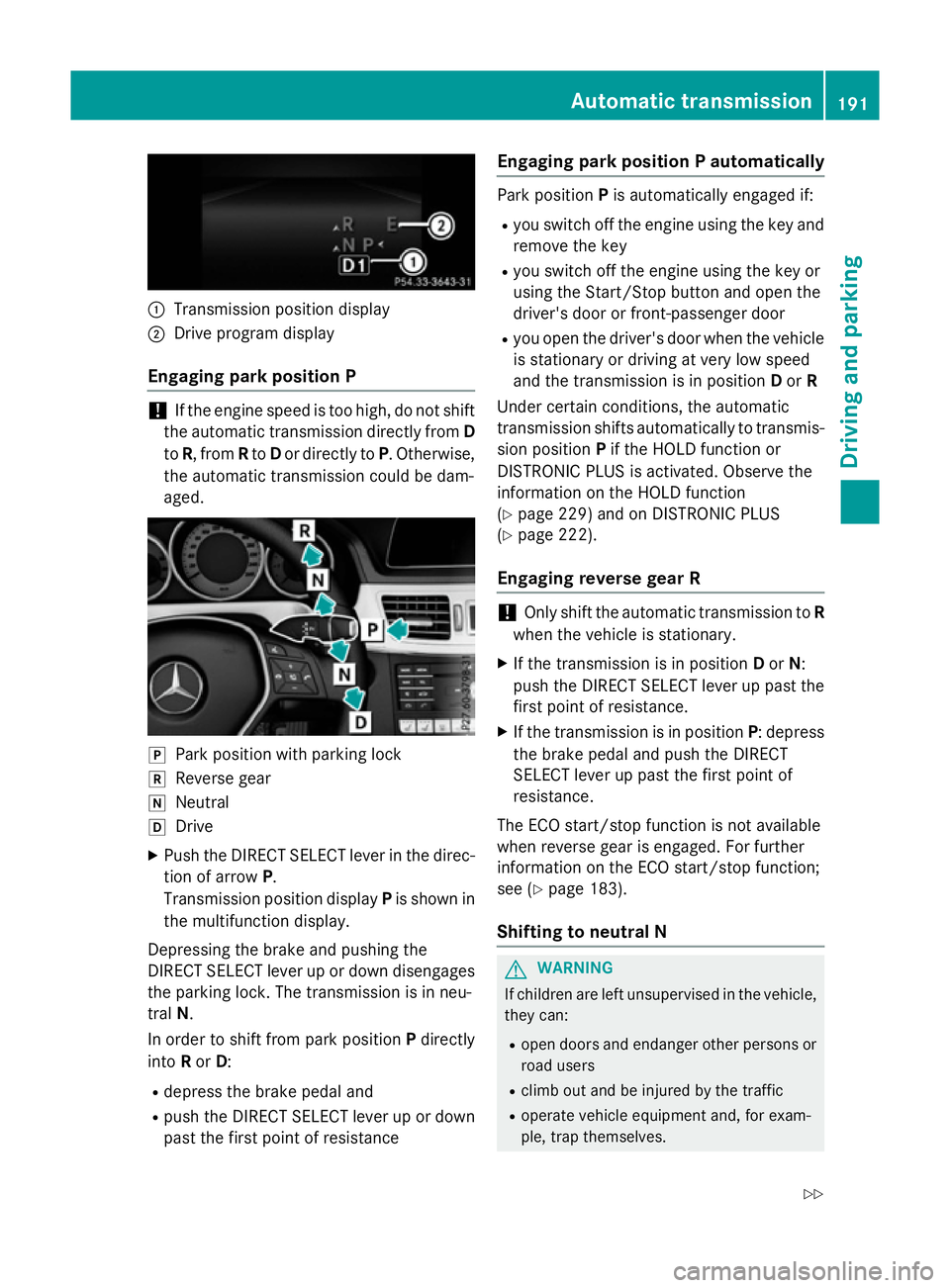
:
Transmission position display
; Drive program display
Engaging parkp osition P !
If the engine speed is too high, do not shift
the automatic transmission directly from D
to R,f rom Rto Dor directly to P.Otherwise,
the automatic transmission could be dam-
aged. j
Park position with parking lock
k Reverse gear
i Neutral
h Drive
X Push the DIRECT SELECT lever in the direc-
tion of arrow P.
Transmission position display Pis shown in
the multifunction display.
Depressin gthe brake and pushing the
DIRECT SELECT lever up or down disengages the parking lock. The transmission is in neu-
tral N.
In order to shift from park position Pdirectly
into Ror D:
R depress the brake pedal and
R push the DIRECT SELECT lever up or down
past the first point of resistance Engaging parkp
ositionPautomatically Park position
Pis automatically engaged if:
R you switch off the engine using the key and
remove the key
R you switch off the engine using the key or
using the Start/Stop button and open the
driver's door or front-passenger door
R you open the driver's door when the vehicle
is stationary or driving at very low speed
and the transmission is in position Dor R
Under certain conditions, the automatic
transmission shifts automatically to transmis-
sion position Pif the HOLD function or
DISTRONIC PLUS is activated. Observe the
information on the HOLD function
(Y page 229) and on DISTRONIC PLUS
(Y page 222).
Engaging reverse gear R !
Only shift the automatic transmission to
R
when the vehicle is stationary.
X If the transmission is in position Dor N:
push the DIRECT SELECT lever up past the first point of resistance.
X If the transmission is in position P:depress
the brake pedal and push the DIRECT
SELECT lever up past the first point of
resistance.
The ECO start/stop function is not available
when reverse gear is engaged. For further
information on the ECO start/stop function;
see (Y page 183).
Shifting to neutral N G
WARNING
If children are left unsupervised in the vehicle, they can:
R open doors and endanger other persons or
road users
R climb out and be injured by the traffic
R operate vehicle equipment and, for exam-
ple, trap themselves. Automatic transmission
191Driving and parking
Z
Page 195 of 497
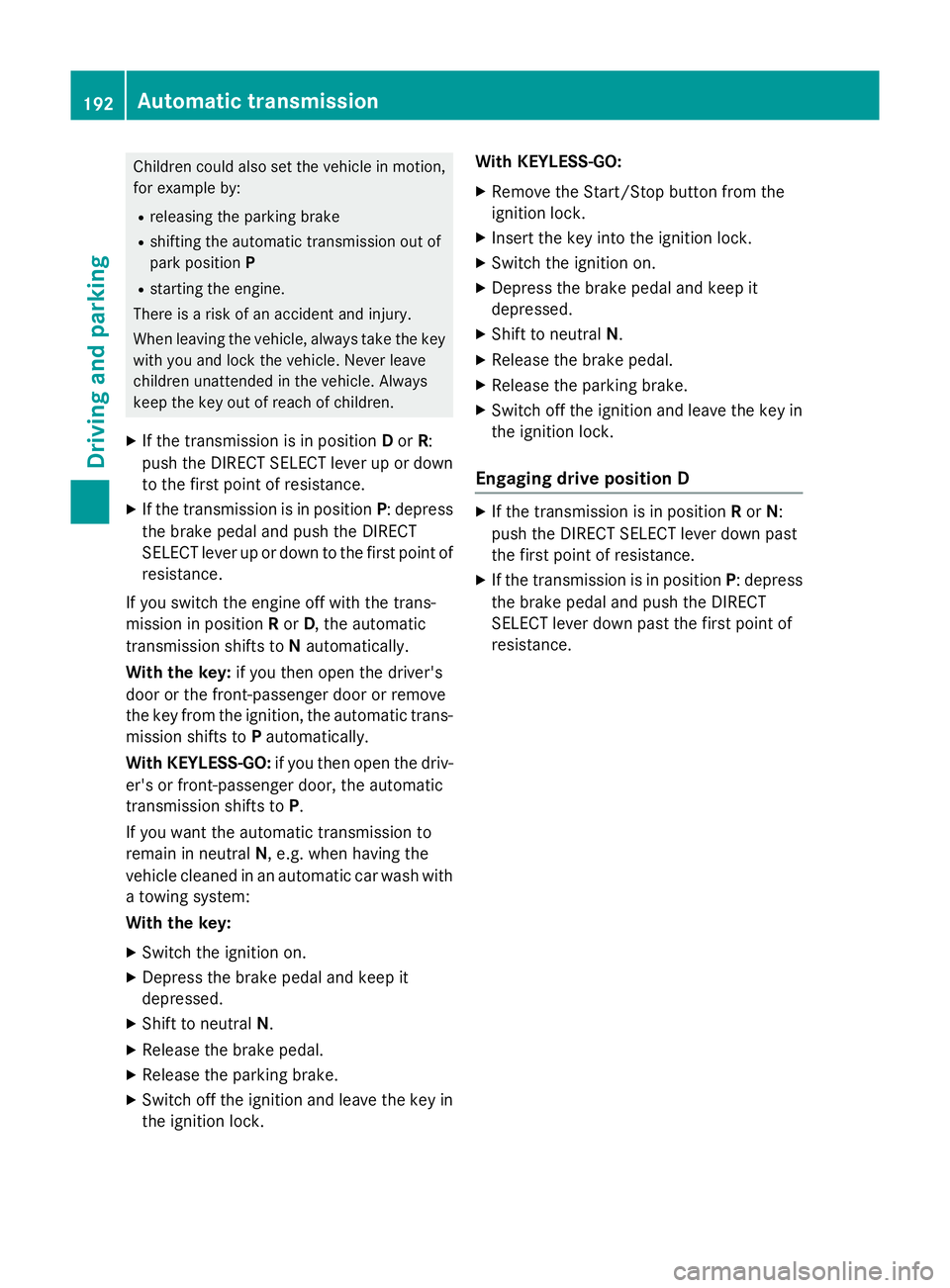
Children could also set th
evehicle in motion,
for example by:
R releasin gthe parking brake
R shiftin gthe automatic transmission out of
park position P
R starting th eengine.
Ther eisar iskofana ccidentand injury.
When leaving th evehicle ,always tak ethe key
wit hyou and loc kthe vehicle .Never leave
children unattende dinthevehicle .Always
keep th ekeyout of reac hofchildren.
X If th etransmission is in position Dor R:
push th eDIRECT SELECT leve rupordown
to th efirst poin tofresistance.
X If th etransmission is in position P:depress
th eb rak epedal and push th eDIRECT
SELECT leve rupordown to th efirst poin tof
resistance.
If you switch th eengineo ff wit hthe trans-
mission in position Ror D,t heautomatic
transmission shifts to Nautomatically.
Wit hthe key: if you then open th edriver's
door or th efront-pa ssenger door or remove
th ek eyfrom th eignition ,the automatic trans-
mission shifts to Pautomatically.
Wit hKEYLESS-GO: if you then open th edriv-
er' sorf ront-pa ssenger door ,the automatic
transmission shifts to P.
If you want th eautomatic transmission to
remain in neutral N,e.g.w hen havin gthe
vehicle cleane dinanautomatic car wash with
at ow ing system:
Wit hthe key:
X Switch th eignition on.
X Depres sthe brak epedal and keep it
depressed.
X Shift to neutral N.
X Release th ebrak epedal.
X Release th eparking brake.
X Switch off th eignition and leave th ekeyin
th ei gnition lock. Wit
hKEYLESS-GO:
X Remove th eStart/Sto pbutto nfromt he
ignition lock.
X Inser tthe keyintot he ignition lock.
X Switch th eignition on.
X Depres sthe brak epedal and keep it
depressed.
X Shift to neutral N.
X Release th ebrak epedal.
X Release th eparking brake.
X Switch off th eignition and leave th ekeyin
th ei gnition lock.
Engaging drive position D X
If th etransmission is in position Ror N:
push th eDIRECT SELECT leve rdown past
th ef irst poin tofresistance.
X If th etransmission is in position P:depress
th eb rak epedal and push th eDIRECT
SELECT leve rdown past th efirst poin tof
resistance. 192
Automatic transmissionDriving and parking
Page 208 of 497
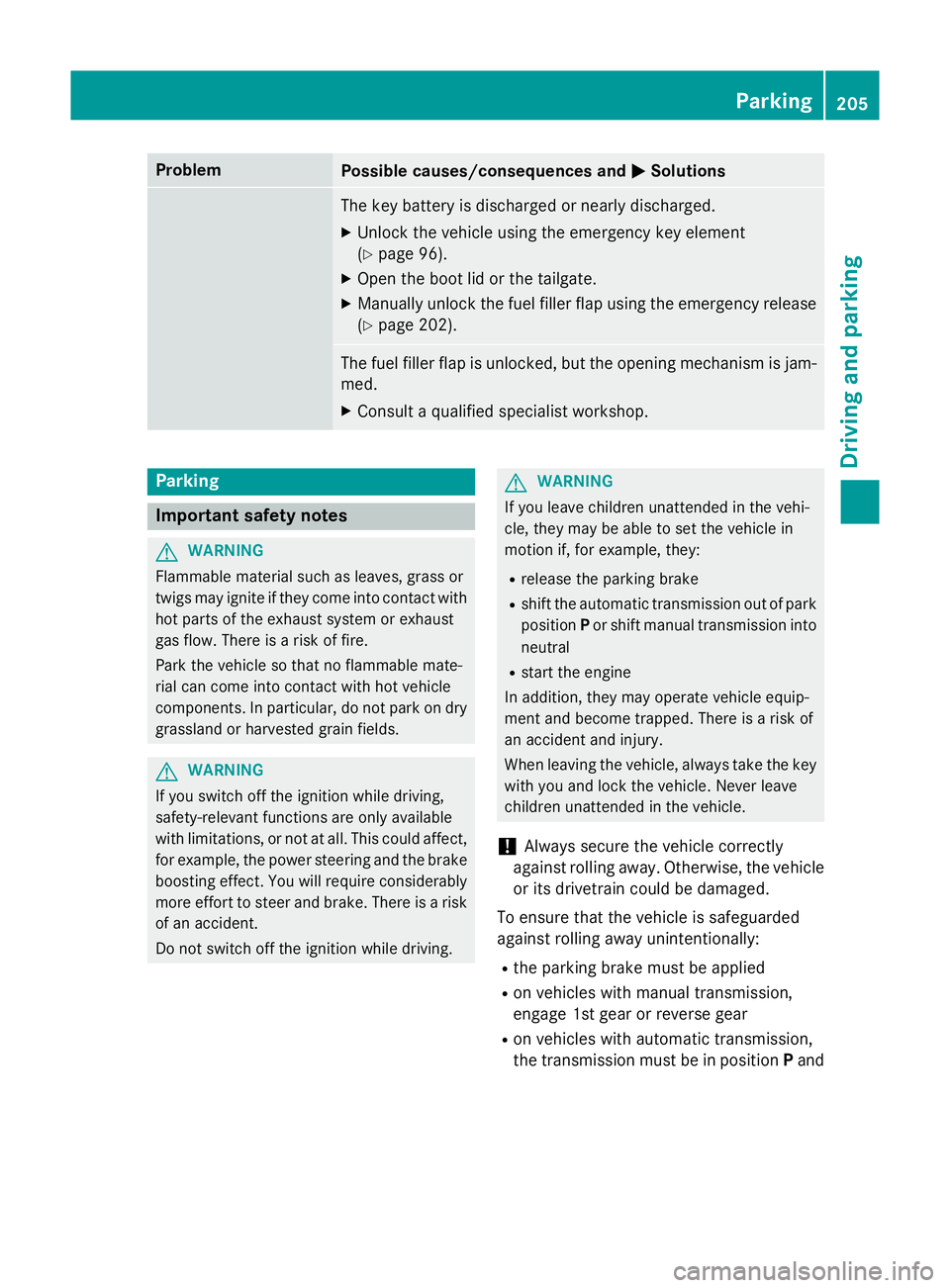
Problem
Possible causes/consequences and
M
MSolutions The key battery is discharged or nearly discharged.
X Unlock the vehicle using the emergency key element
(Y page 96).
X Open the boot lid or the tailgate.
X Manuallyu nlock the fuel filler flap using the emergency release
(Y page 202). The fuel filler flap is unlocked, but the opening mechanism is jam-
med.
X Consult aqualified specialist workshop. Parking
Important safety notes
G
WARNING
Flammable material such as leaves, grass or
twigs may ignite if they come into contact with hot parts of the exhaust system or exhaust
gas flow. There is arisk of fire.
Park the vehicle so that no flammable mate-
rial can come into contact with hot vehicle
components. In particular, do not park on dry grassland or harvested grain fields. G
WARNING
If you switch off the ignition while driving,
safety-relevant functions are only available
with limitations, or not at all. This could affect, for example, the power steering and the brake
boosting effect.Y ou will require considerably
more effort to steer and brake. There is arisk
of an accident.
Do not switch off the ignition while driving. G
WARNING
If you leave children unattended in the vehi-
cle, they may be able to set the vehicle in
motion if, for example, they:
R release the parking brake
R shift the automatic transmission out of park
position Por shift manual transmission into
neutral
R start the engine
In addition, they may operate vehicle equip-
ment and become trapped. There is arisk of
an accident and injury.
When leaving the vehicle, always take the key with you and lock the vehicle. Never leave
children unattended in the vehicle.
! Always secure the vehicle correctly
against rolling away.O therwise, the vehicle
or its drivetrain could be damaged.
To ensure that the vehicle is safeguarded
against rolling away unintentionally:
R the parking brake must be applied
R on vehicles with manual transmission,
engage 1st gear or reverse gear
R on vehicles with automatic transmission,
the transmission must be in position Pand Parking
205Driving and parking Z
Page 210 of 497
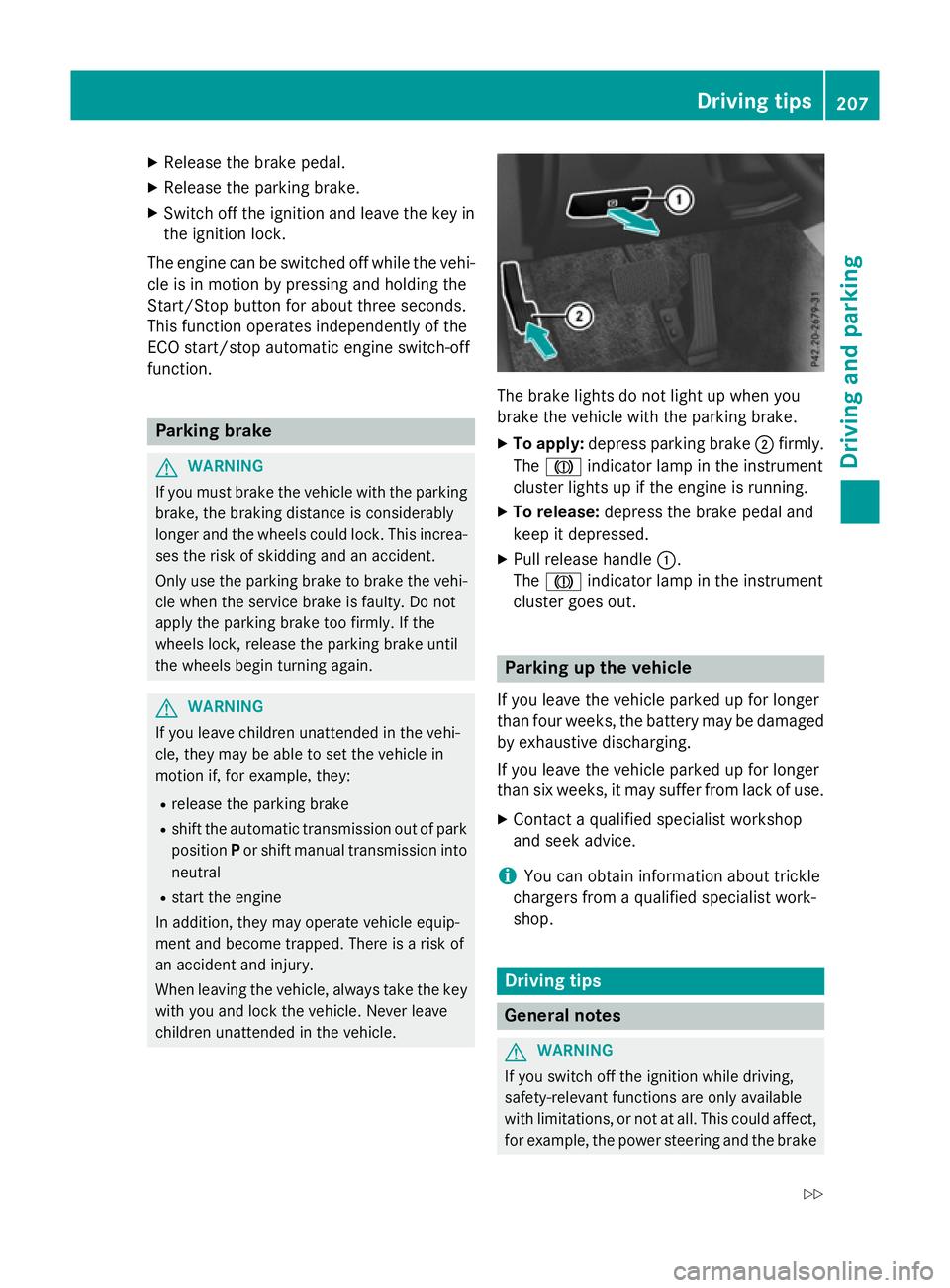
X
Releas ethe brak epedal.
X Releas ethe parkin gbrake.
X Switc hoff th eignition and leav ethe keyin
th ei gnition lock.
The engin ecan be switched off while th evehi-
cle is in motion by pressing and holdin gthe
Start/Sto pbutto nfor about three seconds.
This function operate sind ependentl yofthe
ECO start/sto pautomatic engin eswitch-off
function. Parking brake
G
WARNING
If you mus tbrak ethe vehicl ewitht he parking
brake, th ebrakin gdistanc eisconsid erably
longer and th ewheels could lock. This increa-
ses th eriskofs kiddin gand an accident.
Only use th eparkin gbrak etob rakethe vehi-
cle when th eservic ebrak eisf aulty. Do not
apply th eparkin gbrak etoo firmly. If the
wheels lock, release th eparkin gbrak euntil
th ew heels begi nturning again. G
WARNING
If you leav echildren unattended in th evehi-
cle ,the ym ay be able to set th evehicl ein
motion if, for example, they:
R release th eparkin gbrake
R shift th eautomati ctransmission out of park
position Por shift manual transmission into
neutral
R start th eengine
In addition ,the ym ay operate vehicl eequip-
men tand become trapped .There is ariskof
an acciden tand injury.
Whe nleavin gthe vehicle, always tak ethe key
wit hyou and loc kthe vehicle. Never leave
children unattended in th evehicle. The brak
elights do no tligh tupw hen you
brak ethe vehicl ewitht he parkin gbrake.
X To apply: depress parkin gbrake ;firmly.
The J indicato rlamp in th einstrument
cluste rlights up if th eengineisr unning.
X To release: depress thebrak epedal and
keep it depressed.
X Pull release handle :.
The J indicato rlamp in th einstrument
cluste rgoeso ut. Parking up th
evehicle
If you leav ethe vehicl eparked up for longer
than fou rweeks, th ebattery may be damaged
by exhaustive discharging.
If you leav ethe vehicl eparked up for longer
than six weeks, it may suffer from lack of use.
X Contac taqualified specialist workshop
and see kadvice.
i You can obtain information about trickle
chargers from aqualified specialist work-
shop. Driving tips
Genera
lnotes G
WARNING
If you switch off th eignition while driving,
safety-relevant function sare only available
wit hlimitations, or no tatall. This could affect,
for example, th epowe rsteerin gand th ebrake Driving tips
207Driving and pa rking
Z
Page 352 of 497
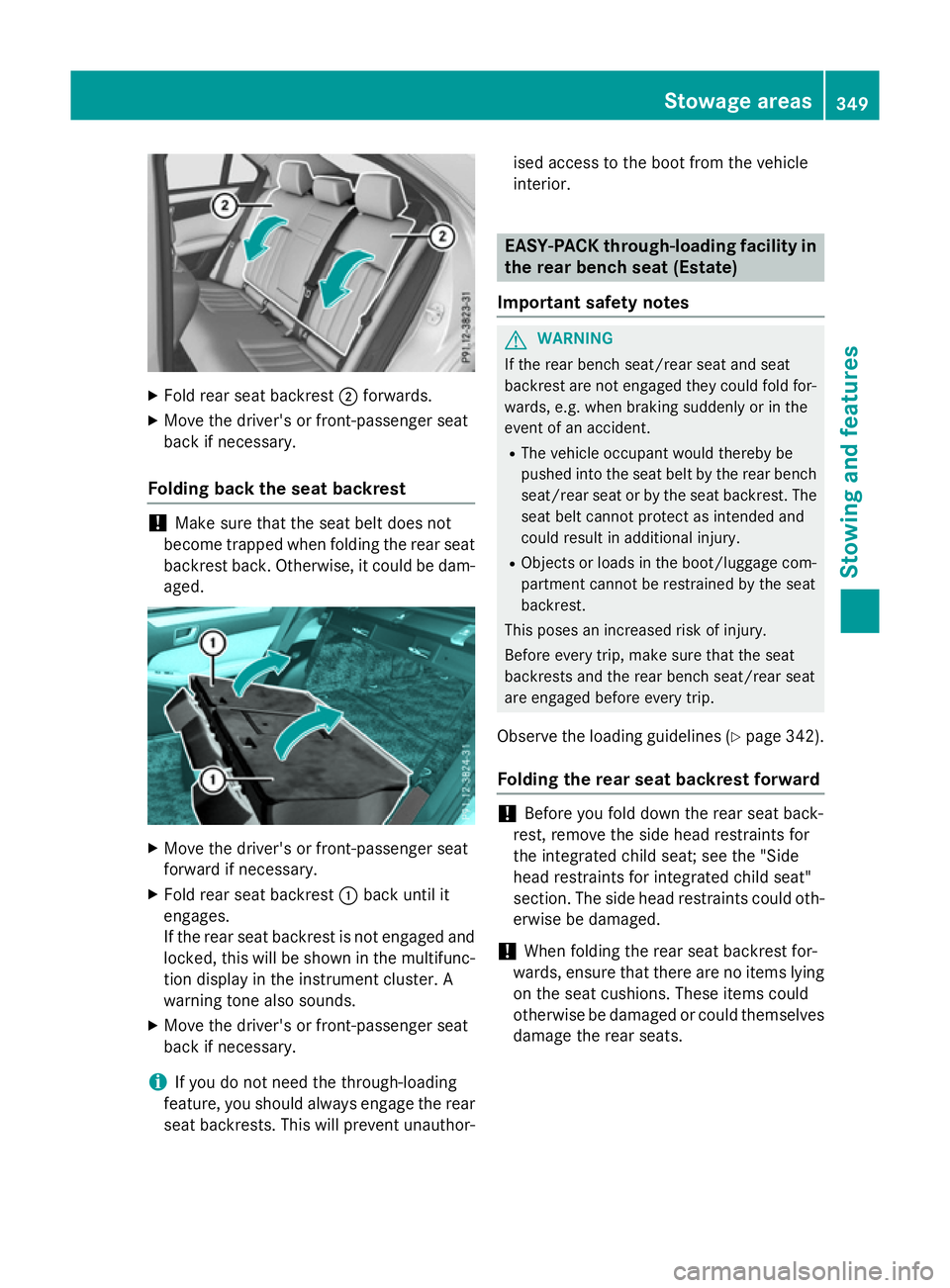
X
Fold rea rseatb ackrest ;forwards.
X Move the driver' sorfront-passenger seat
back if necessary.
Folding bac kthe seat backrest !
Make sure that the sea
tbeltd oesn ot
become trapped whe nfolding the rea rseat
backrest back. Otherwise, it could be dam- aged. X
Move the driver' sorfront-passenger seat
forward if necessary.
X Fold rea rseatb ackrest :back unti lit
engages.
If the rea rsea tb ackrest is not engaged and
locked, this will be shown in the multifunc-
tion display in the instrument cluster. A
warning tone also sounds.
X Move the driver' sorfront-passenger seat
back if necessary.
i If yo
udon ot need the through-loading
feature ,you shoul dalway sengage the rear
sea tbackrests. Thi swillp revent unauthor- ise
da ccess to the boo tfrom the vehicle
interior. EASY-PACK through-loadin
gfacility in
the rear benc hseat(Es tate)
Important safety notes G
WARNING
If the rea rbench seat/rea rseata nd seat
backrest are not engaged they could fol dfor-
wards, e.g. whe nbraking suddenl yorinthe
event of an accident.
R The vehicle occupant would thereby be
pushe dinto the sea tbeltb ythe rea rbench
seat/rea rseatorb ythe sea tbackrest. The
sea tbeltc annot protect as intended and
could result in additiona linjury.
R Objects or loads in the boot/luggage com-
partment cannot be restrained by the seat
backrest.
Thi sp oses an increase driskofi njury.
Befor eevery trip ,make sur ethat the seat
backrests and the rea rbench seat/rea rseat
are engaged before every trip.
Observe the loading guidelines (Y page 342).
Folding the rear seat backres tforward !
Befor
eyou foldd ownthe rea rseatb ack-
rest, remove the sid eheadr estraints for
the integrate dchilds eat; see the "Side
hea drestraints for integrate dchilds eat"
section. The sid eheadr estraints could oth-
erwise be damaged.
! Whe
nfolding the rea rseatb ackrest for-
wards, ensure that there are no item slying
on the sea tcushions .These item scould
otherwise be damaged or could themselves
damag ethe rea rseats. Stowage areas
349Stowingand features Z
Page 406 of 497
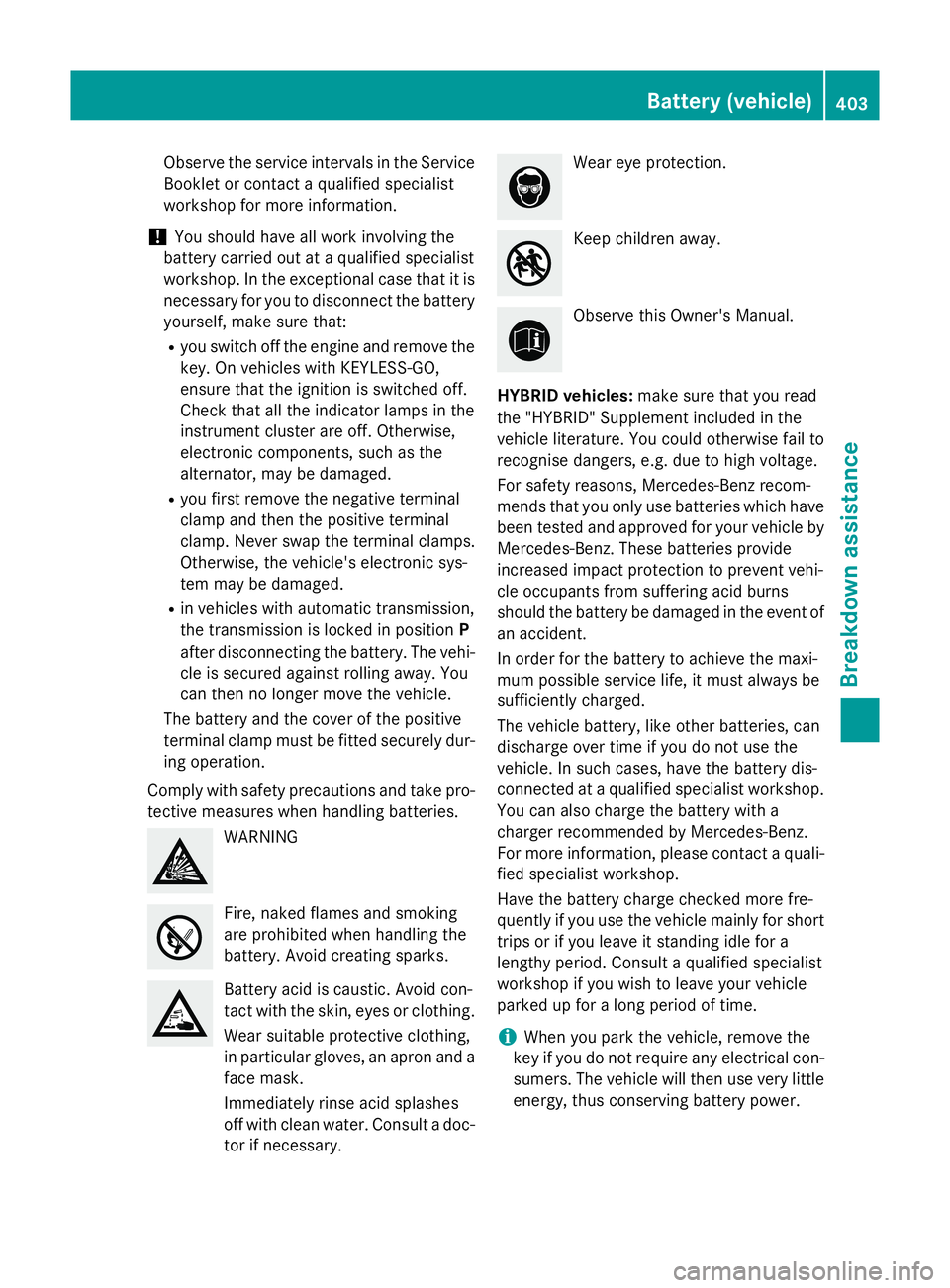
Observe the service intervals in the Service
Booklet or contact aqualified specialist
workshop for more information.
! You should have all work involving the
battery carried out at aqualified specialist
workshop. In the exceptional case that it is
necessary for you to disconnect the battery yourself, make sure that:
R you switch off the engine and remove the
key. On vehicles with KEYLESS-GO,
ensure that the ignition is switched off.
Check that all the indicator lamps in the
instrument cluster are off. Otherwise,
electronic components, such as the
alternator, may be damaged.
R you first remove the negative terminal
clamp and then the positive terminal
clamp. Never swap the terminal clamps.
Otherwise, the vehicle's electronic sys-
tem may be damaged.
R in vehicles with automatic transmission,
the transmission is locked in position P
after disconnecting the battery. The vehi-
cle is secured against rolling away. You
can then no longer move the vehicle.
The battery and the cover of the positive
terminal clamp must be fitted securely dur- ing operation.
Comply with safety precautions and take pro-
tective measures when handling batteries. WARNING
Fire, naked flames and smoking
are prohibited when handling the
battery. Avoid creating sparks.
Battery acid is caustic. Avoid con-
tact with the skin, eyes or clothing.
Wear suitablep rotective clothing,
in particularg loves, an apron and a
face mask.
Immediately rinse acid splashes
off with clean water. Consult adoc-
tor if necessary. Wear eye protection.
Keep children away.
Observe this Owner's Manual.
HYBRID vehicles: make sure that you read
the "HYBRID" Supplement included in the
vehicle literature. You could otherwise fail to
recognise dangers, e.g. due to high voltage.
For safety reasons, Mercedes-Benz recom-
mends that you only use batteries which have been tested and approved for your vehicle by
Mercedes-Benz.T hese batteries provide
increased impact protection to prevent vehi-
cle occupants from suffering acid burns
should the battery be damagedint he event of
an accident.
In order for the battery to achieve the maxi-
mum possibles ervice life, it must always be
sufficiently charged.
The vehicle battery, like other batteries, can
discharge over time if you do not use the
vehicle. In such cases, have the battery dis-
connected at aqualified specialist workshop.
You can also charge the battery with a
charger recommended by Mercedes-Benz.
For more information, pleasec ontactaquali-
fied specialist workshop.
Have the battery charge checked more fre-
quently if you use the vehicle mainly for short
trips or if you leave it standing idle for a
lengthy period. Consult aqualified specialist
workshop if you wish to leave your vehicle
parked up for along period of time.
i When you park the vehicle, remove the
key if you do not require any electrical con-
sumers. The vehicle will then use very little energy, thus conserving battery power. Battery (vehicle)
403Breakdown assistance Z